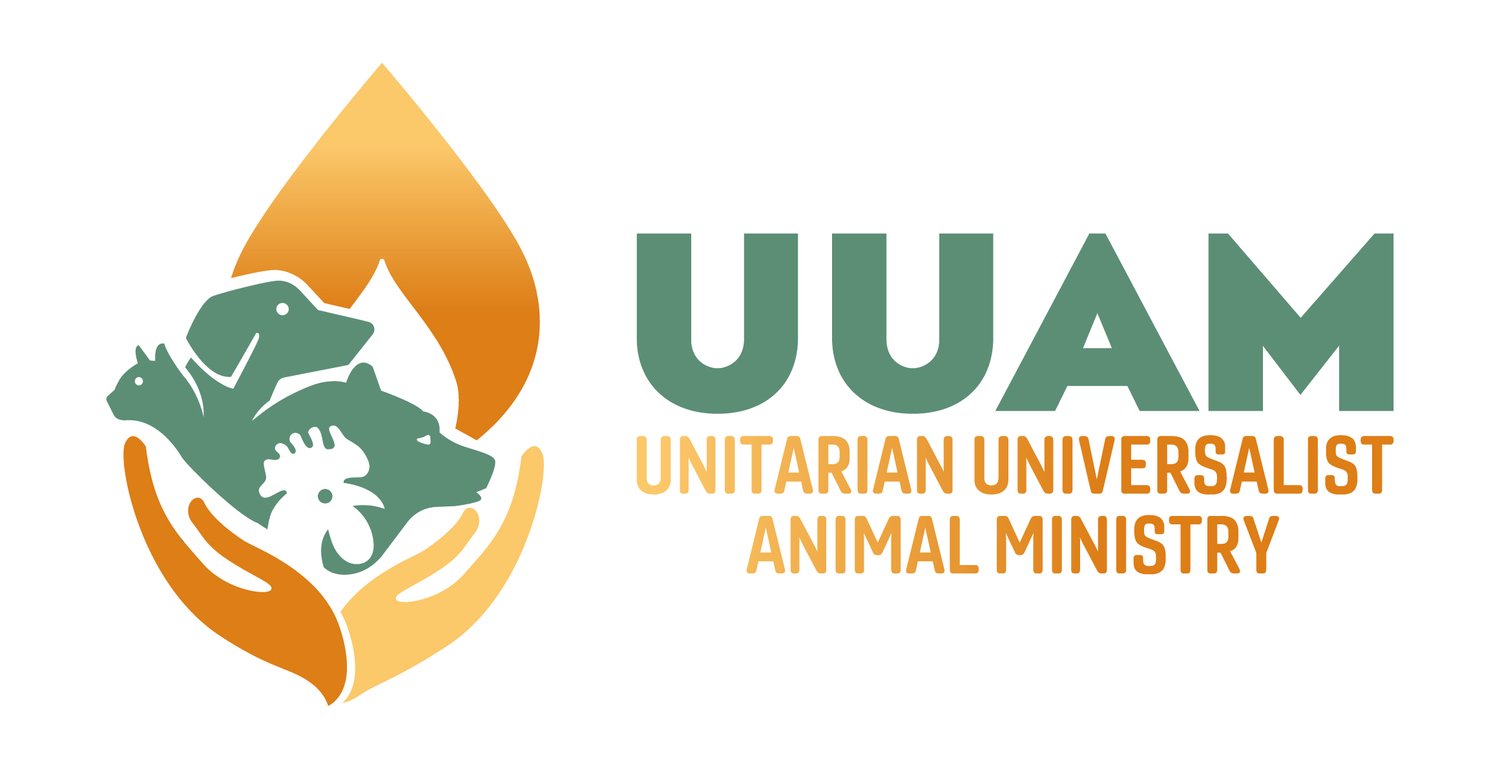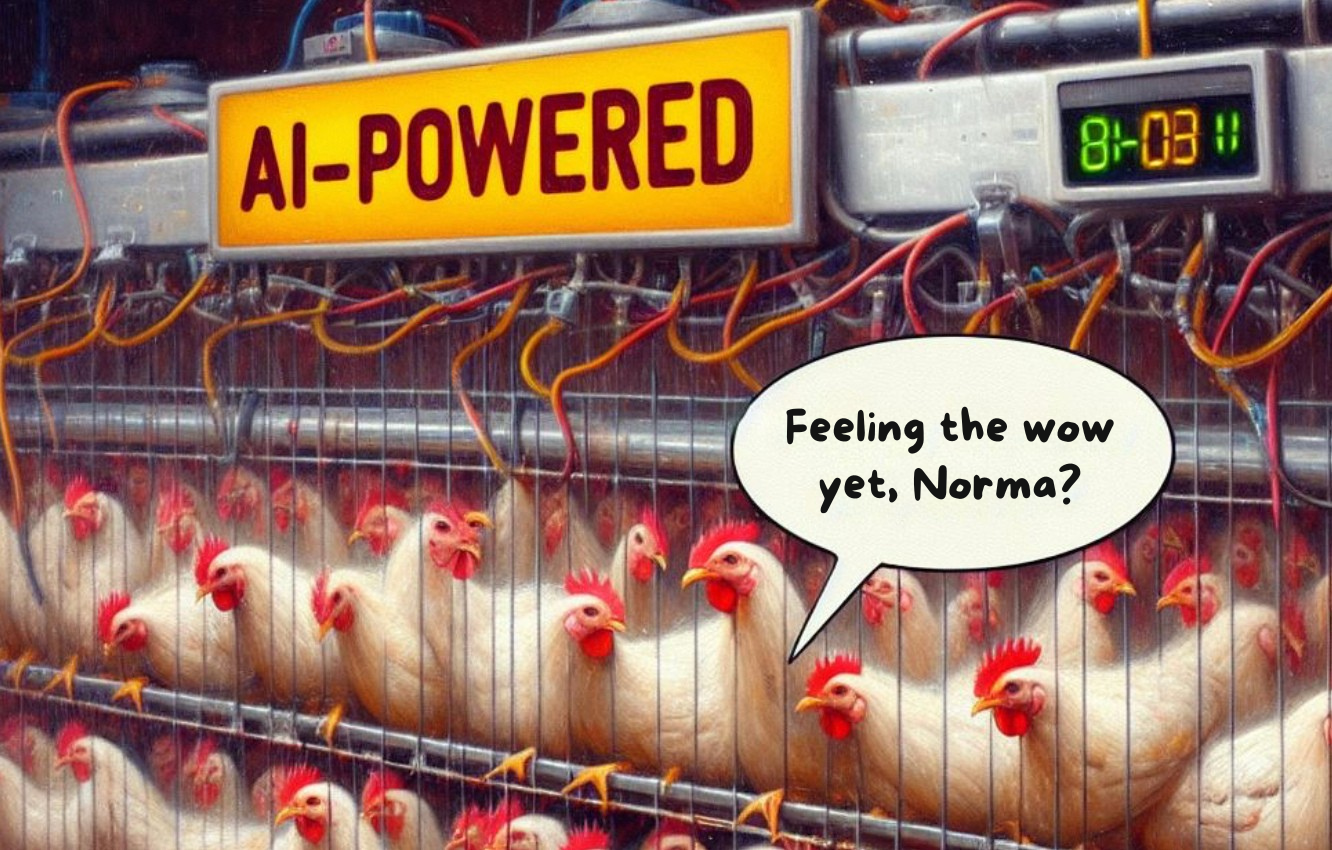AI on Factory Farms: Wow or Woe for Farmed Animals?
Introduction
Artificial intelligence (AI) on factory farms, a.k.a. Concentrated Animal Feeding Operations (CAFOs), is new and quickly evolving. As with other AI uses, it can wow. Whether it means more wows or woes for farmed animals is the focus of this article. Let's examine how CAFOs use AI and its promises and perils for tens of billions of animals worldwide confined in CAFOs each year.
How do CAFOs use AI?
In CAFOs, AI uses advanced technology to analyze data collected from animals and their surroundings. This data, often gathered in real-time, comes from sensors, cameras, scanners, sound devices, temperature loggers, GPS, and similar devices placed in, on or near the animals.
What do CAFOs say are the benefits of AI?
CAFOs and AI providers promote AI as a versatile digital Swiss army knife tool for improving profitability, efficiency, productivity, management, resource utilization, quality assurance, and animal welfare.
How might AI improve CAFO animal welfare?
CAFO AI supporters highlight many animal welfare benefits:
Diet: AI-assisted devices can help ensure appropriate food and water.
Health: AI-assisted health monitoring tools for animal groups and for individual animals — the latter being rough analogs to human health and fitness apps — can help CAFOs identify and treat sick or injured animals more promptly.
Disease: AI algorithms, the instructional DNA for AI, can analyze data and identify patterns associated with disease outbreaks, allowing timely preventive measures.
Environment: AI-powered sensors can monitor and control environmental conditions like temperature, humidity, ventilation, air quality and lighting, improving overall animal health and stress levels.
Violation detection: AI can help detect animal welfare violations, allowing remedial measures by CAFOs and possibly investigation and prosecution by regulators.
How might AI harm CAFO animals?
For at least the following reasons, skeptics and opponents of CAFO AI warn that it’s more akin to a wolf in sheep’s clothing or a doom loop that will likely worsen animal welfare:
Proof: While CAFO AI supporters claim it improves animal welfare, evidence remains limited.
Prioritization: Historically, CAFOs prioritized production and profits over animal welfare; AI won’t change that entrenched attitude. How, for instance, can CAFOs that slaughter chickens raised for meat at about 42 days old be trusted to expend the time and money appropriate for their well-being?
Crowding: AI may enable more chickens, pigs and other animals to be crowded in the same space.
Welfare defined: CAFO AI algorithms will likely define welfare restrictively, concentrating on health, not overall life quality.
Weakened algorithms: CAFOs can intentionally “dial down” or massage animal welfare algorithms to deliberately undermine the detection of welfare issues that might impede production or attract regulatory or consumer scrutiny.
Secret algorithms: CAFOs —which already hide their conditions behind Ag-Gag laws — are unlikely to be transparent about their algorithms, lessening their accountability.
Regulation: Traditionally, CAFO animal welfare regulators have imposed few restrictions relating to animal welfare. While AI regulations directly impacting humans seem imminent, CAFO AI regulations will likely fall in the last-and-least-if-at-all category.
Meat demand: If, as advertised, CAFO AI increases efficiency, meat prices might fall, meaning increased meat demand. Also, because AI providers and CAFOs claim that AI improves welfare, consumers could accept meat as more ethical, fueling and broadening its consumption.
Meat Alternatives: The plant-based and cultivated meat products market could plummet if animal meat prices decline.
Malfunctions: AI systems can fail or malfunction, harming numerous animals. Because AI usually displaces workers, backup human support may be unavailable.
Assessments: Animal behavior is complex, so AI systems can miss or misdiagnose signs of illness and stress, causing delayed treatment.
Husbandry skills: With reduced and more remote human connection between CAFO personnel and animals, animal-oriented husbandry skills will erode.
Sensor discomfort: Not surprisingly, some animals feel discomfort from AI-related sensors in or on them.
Intentional abuse: CAFO history is plagued with deliberate animal abuse. AI could facilitate systematic, intentional mistreatment.
Breeding techniques/genetic modifications: AI could enhance breeding techniques and genetic modifications to maximize productivity while compromising animal well-being.
CAFO Perpetuation: Perhaps most significantly, even if AI marginally improves animal welfare, it will likely entrench CAFOs and their most harmful business-as-usual practices — which AI isn’t designed to eliminate and CAFOs have not promised to eliminate. These include cramped conditions, inability to behave naturally, lack of outdoors and sunlight, breeding practices promoting rapid growth over health, unnatural antibiotics and hormones, cruel and stressful slaughter practices, short lifespans, physical alterations like teeth-clipping or tail-docking, debeaking and beak trimming, and chick culling. While CAFOs attempt to create a brighter and cheerier story of post-AI CAFOs, it remains dystopian — think 1984 rather than Charlotte’s Web.
In their 2023 article entitled, What AI Means for Animals, Peter Singer and Tse Yip Fai concluded:
While all of these impacts [of AI on animals] need ethical assessment, the area in which AI has by far the most significant impact on animals is factory farming. The use of AI in factory farms will, in the long run, increase the already huge number of animals who suffer in terrible conditions ... You might be thinking that this would benefit the animals — that it means they will get sick less often, and when they do get sick, the problems will be quickly identified and cured, with less room for human error. But the short-term animal welfare benefits brought about by AI are, in our view, clearly outweighed by other consequences.
Conclusion
Discussing the future of CAFO AI, the authors of The Dangers of AI Farming warn that “the genie is out of the bottle.” I suspect that’s true. If so, what to do? No one makes silver bullets for these situations. Still, some options for animal welfare groups, experts or advocates include researching and monitoring AI’s impact in CAFOs, participation in CAFO AI design and standards, demanding transparency about CAFO AI algorithms, advocating for robust regulations, and running campaigns to ensure that consumers look behind the curtain of CAFO AI animal welfare claims. Of course, ethical leaders in the protection of farmed animals, like Unitarian Universalists, can learn about and speak out about the perils of AI on behalf of CAFO-confined animals.
This article is based on many scholarly papers, news articles and other information, including the recommended articles below. Next month's article focuses on AI's potential to reduce or replace traditional animal testing.
-Frank Brown, UU of Arlington, Va.
Further Reading
What AI means for Animals (Peter Singer and Tse Yip Fai, 2023)
The dangers of AI farming (Virginie Simoneau-Gilbert and Jonathan Birchis, 2024)
The Dangers of AI Farming (Virginie Simoneau-Gilbert and Jonathan Birchis, 2024)
Twelve Threats of Precision Livestock Farming (PLF) for Animal Welfare (Frank A.M. Tuyttens, Carla F.M. Molento and Said Benaissa, 2022)
AI-Based Smart Farming. The Rise of Machine Learning in Livestock Farming (Dorota Owczarek, 2022)
What AI could mean for animals (Max Taylor, 2023)
Artificial intelligence in animal farming: A systematic literature review (Jun Bao and Qiuju Xie, 2022)

